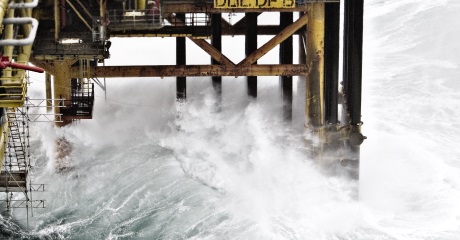Structural Integrity and Lifetime Evaluation
We are working to extend the lifetime and reliability of current offshore platforms in the North Sea. To facilitate continued safe operation in the ever-changing environmental conditions, new research is needed.

Many platforms in the Danish North Sea were built in the early 1980s with a typical design life from 20 to 30 years. Now, up to 40 years and several repairs and modifications later, we investigate the state of the platforms and assess the measures needed to maintain these as fit for continued production.
The research is carried out in close collaboration with the offshore industry. Our researchers have therefore access to a large amount of data and knowledge and in this way, the distance from idea to applied research is short.
This work is done to understand the intriguing natural interactions between structural and environmental conditions and how prolonged exposure affects their structural integrity.
Structural fatigue
Offshore steel structures face a perpetual battle against the combined effects of wind, waves, and salt exposure. These aggressive conditions induce complex fatigue loading, leading to progressive material degradation and a reduction in ultimate strength.
Utilizing modal analysis, we delve into the dynamics of these installations to pinpoint critical stress concentrations and quantify the precise level of fatigue damage accumulated. This detailed assessment provides invaluable insights into the remaining structural integrity, enabling proactive measures to ensure continued safe operation and mitigate potential failure risks.
Extreme waves
The recent observation of a breaking wave under the Tyra platform – a waveform previously considered infeasible at such offshore locations – highlights the need for further knowledge on wave patterns and frequencies.
Breaking waves have a completely different and concentrated force compared to regular waves, and therefore we are investigating whether previous wave impact calculations have been sufficiently conservative in terms of securing platforms and personnel. Further, we are developing a method to detect placement and frequency of breaking waves using LIDAR technology.
Risk model
An advanced risk model including value of information evaluations is being developed. It will combine the knowledge obtained on structural fatigue and wave loading throughout the research programme. The improved knowledge provides an assessment of the failure risk, thus supporting the operator to make risk-based decisions on the structural health and evaluate the need for repair and inspections.
Placement of possible new platforms
Alongside the work on the existing platforms, we have also done research on how advanced interpretation of shallow seismic surveys can assist in evaluating where to place new structures based on expected strength of the seabed.
Contact
Ulla Hoffmann Programme Manager Danish Offshore Technology Centre Mobile: 9351 1360 uhoff@dtu.dk